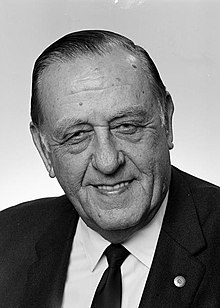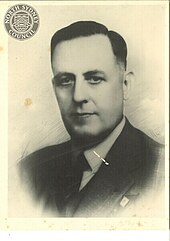| The HonourableSir John Cramer | |
|---|---|
 Cramer in 1971 Cramer in 1971 | |
| Minister for the Army | |
| In office 28 February 1956 – 18 December 1963 | |
| Prime Minister | Robert Menzies |
| Preceded by | Eric Harrison |
| Succeeded by | Jim Forbes |
| Member of the Australian Parliament for Bennelong | |
| In office 10 December 1949 – 11 April 1974 | |
| Preceded by | Division created |
| Succeeded by | John Howard |
| Mayor of North Sydney | |
| In office 20 December 1939 – 6 December 1941 | |
| Deputy | George Fowle |
| Preceded by | James Stanton |
| Succeeded by | George Fowle |
| Personal details | |
| Born | John Oscar Cramer (1896-02-18)18 February 1896 Quirindi, New South Wales |
| Died | 18 May 1994(1994-05-18) (aged 98) Sydney, New South Wales, Australia |
| Political party | UAP (to c. 1944) Democratic (1944) Liberal (from 1945) |
| Spouse |
Mary Therese Earls
(m. 1922; died 1984) |
Sir John Oscar Cramer (18 February 1896 – 18 May 1994) was an Australian businessman and politician. He was a member of the Liberal Party and served in federal parliament from 1949 to 1974, representing the seat of Bennelong. He served as Minister for the Army in the Menzies government from 1956 to 1963. He was also mayor of North Sydney from 1939 to 1941.
Early life
Cramer was born on 18 February 1896 at Jacob and Joseph Creek near Quirindi, New South Wales. He was the fourth of six children born to Emily Eleanor (née Cullen) and John Nicholas Cramer; his mother was of Scottish and Irish descent and his father of German descent.
Cramer grew up on his father's farm, attending Gaspard Public School until the age of fourteen. He assisted his father with farm work and later managed a fruit shop in Quirindi. In 1917 he moved to Sydney and began working as a clerk with Paramount Pictures. He and his brother Charles were talented musicians and singers and provided musical accompaniment to silent films. In 1920, they established a real estate firm, Cramer Bros., with an office at Crows Nest in North Sydney. Later joined by another brother, Reg, they achieved success through several business ventures including a syndicate subdividing land in Willoughby and a partnership in a building firm specialising in apartment blocks.
Early political involvement

Cramer became active in politics during the Great Depression, joining the All for Australia League which was later incorporated into the United Australia Party (UAP). After the collapse of the UAP in the early 1940s he joined the Democratic Party and was an unsuccessful candidate in the seat of Lane Cove at the 1944 New South Wales state election. He was subsequently involved in the formation of the Liberal Party of Australia (New South Wales Division) and was elected to the party's provisional executive in January 1945.
In 1931, Cramer was elected to the North Sydney Municipal Council in 1931. He was elected as mayor of North Sydney in 1939 and served until his defeat as an alderman at the December 1941 municipal elections. From 1935 to 1956, Cramer served on the Sydney County Council (3rd/4th Constituency). In 1939 and 1945, he was elected Deputy Chairman, and was later elected for three terms as Chairman of the County Council (1946–1947; 1948–1950).
Federal politics
He was elected to the House of Representatives as the inaugural representative of the seat of Bennelong on its creation in 1949. In 1956, the Prime Minister Robert Menzies appointed him Minister for the Army, a portfolio he held until 1963. On 23 January 1956, on his appointment as army minister Cramer resigned his 4th Constituency seat on the county council.
Cramer's service as army minister included the final years of Australia's involvement in the Malayan Emergency and the prelude to Vietnam War. He toured South-East Asia in 1958 and met with South Vietnamese president Ngo Dinh Diem, who had toured Australia the previous year.
Cramer was the only Catholic in the Liberal Party parliamentary team, a fact Menzies would often joke about. He was "ardently opposed to communism, suspicious of socialism, and single-minded in his advocacy of free enterprise".
In 1964 Cramer was created a Knight Bachelor. He remained in parliament as a backbencher for a decade and was critical of Liberal leader John Gorton, supporting his eventual replacement by William McMahon. He announced his retirement from politics in November 1973, and was succeeded by future prime minister John Howard at the MP for Bennelong at the 1974 election. He died on 18 May 1994, aged 98. Cramer had been the last serving parliamentarian born before Federation, and he was the last surviving former MP who was born in the 19th century.
Personal life
In 1922 he married Mary Therese Earls, a teacher, and his elder by two and a half years. The couple had four children: John, Erle, Bronwyn and Leonie. For her four decades of service as a charity worker and community activist, Lady Cramer was created a Dame Commander of the Order of the British Empire in 1971.
Dame Mary Cramer predeceased her husband by almost a decade, dying on 23 September 1984 (aged 91).
Writings
- Cramer, John (1989). Pioneers, politics and people: a political memoir. Sydney: Allen & Unwin. p. 231. ISBN 978-0-04-442104-7.
References
- ^ Kingston, Beverley (2021). "Cramer, Sir John Oscar (Jack) (1896–1994)". Australian Dictionary of Biography. Vol. 19.
- "MAYORAL ELECTIONS". The Sydney Morning Herald. No. 31, 812. New South Wales, Australia. 15 December 1939. p. 16. Retrieved 9 April 2017 – via National Library of Australia.
- "LABOUR LOSES CITY POLL". The Sydney Morning Herald. No. 32, 432. New South Wales, Australia. 8 December 1941. p. 8. Retrieved 9 April 2017 – via National Library of Australia.
- "FOURTH TERM IN ROW". The Sun. New South Wales, Australia. 10 January 1945. p. 7. Retrieved 8 March 2021 – via National Library of Australia.
- "McElhone Chairman". The Sun. New South Wales, Australia. 23 January 1945. p. 2. Retrieved 8 March 2021 – via National Library of Australia.
- "COUNTY COUNCIL CHAIRMAN". The Sydney Morning Herald. New South Wales, Australia. 16 January 1946. p. 4. Retrieved 4 March 2017 – via National Library of Australia.
- "New Chairman Of County Council". The Sun. New South Wales, Australia. 15 January 1946. p. 5. Retrieved 7 March 2021 – via National Library of Australia.
- "SYDNEY COUNTY COUNCIL". Construction. New South Wales, Australia. 30 January 1946. p. 3. Retrieved 7 March 2021 – via National Library of Australia.
- "County Council Chairman Elected". National Advocate. New South Wales, Australia. 21 January 1948. p. 1. Retrieved 7 March 2021 – via National Library of Australia.
- "Tie-up charge in County Council election". The Sun. New South Wales, Australia. 20 January 1948. p. 2. Retrieved 7 March 2021 – via National Library of Australia.
- "The Hon John Howard MP, Member for Bennelong (NSW), First Speech To Parliament". Hansard. Parliament of Australia. 26 September 1974. Archived from the original on 30 August 2007. Retrieved 28 August 2007.
- MAYORAL ELECTIONS
- "Army Minister Leaves Council". The Sydney Morning Herald. 24 January 1956. p. 4.
- "The Sydney County Council - Extraordinary Election". The Sydney Morning Herald. 13 March 1956. p. 15.
- Abjorensen, Norman. "Australia's great political shift". Inside Story. School of Arts, Social Sciences & Humanities, Swinburne University of Technology. Retrieved 31 July 2017.
- "Cramer, John Oscar". It's an Honour. Retrieved 28 August 2007.
- "Two MPs retiring". The Canberra Times. 8 November 1973.
- "CONDOLENCES - Hon. Sir John Oscar Cramer". Hansard. Parliament of Australia. 30 May 1994.
- Earls Family Chronicles
- "Cramer, Dame Mary Therese". Australian Women. National Foundation for Australian Women. Retrieved 28 August 2007.
| Civic offices | ||
|---|---|---|
| Preceded byJames Street Stanton | Deputy Mayor of North Sydney 1937 – 1939 |
Succeeded byGeorge Augustus Fowle |
| Preceded byJames Street Stanton | Mayor of North Sydney 1939 – 1941 |
Succeeded byGeorge Augustus Fowle |
| Government offices | ||
| New title | Councillor of the Sydney County Council 3rd Constituency 1935 – 1949 |
Succeeded byReginald William Bieler Thomas Hogan |
| New title | Councillor of the Sydney County Council 4th Constituency 1949 – 1956 Served alongside: William Parker Henson |
Succeeded byGeorge Ivan Ferris |
| Preceded byStanley Parry | Deputy Chairman of the Sydney County Council 1939 – 1940 |
Succeeded byStanley Parry |
| Preceded byArthur McElhone | Deputy Chairman of the Sydney County Council 1945 – 1946 |
Succeeded byArthur McElhone |
| Preceded byArthur McElhone | Chairman of the Sydney County Council 1946 – 1947 |
Succeeded byFrank Grenville Pursell |
| Preceded byFrank Grenville Pursell | Chairman of the Sydney County Council 1948 – 1950 |
Succeeded byWilliam Parker Henson |
| Parliament of Australia | ||
| New division | Member for Bennelong 1949 – 1974 |
Succeeded byJohn Howard |
| Political offices | ||
| Preceded byEric Harrison | Minister for the Army 1956 – 1963 |
Succeeded byJames Forbes |
- 1896 births
- 1994 deaths
- Politicians from Sydney
- Deputy mayors of places in Australia
- Mayors of North Sydney
- Liberal Party of Australia members of the Parliament of Australia
- Members of the Australian House of Representatives for Bennelong
- Members of the Australian House of Representatives
- Australian Knights Bachelor
- Australian Roman Catholics
- Councillors of Sydney County Council
- People from Quirindi
- Australian MPs 1949–1951
- Australian MPs 1951–1954
- Australian MPs 1954–1955
- Australian MPs 1955–1958
- Australian MPs 1958–1961
- Australian MPs 1961–1963
- Australian MPs 1963–1966
- Australian MPs 1966–1969
- Australian MPs 1969–1972
- Australian MPs 1972–1974